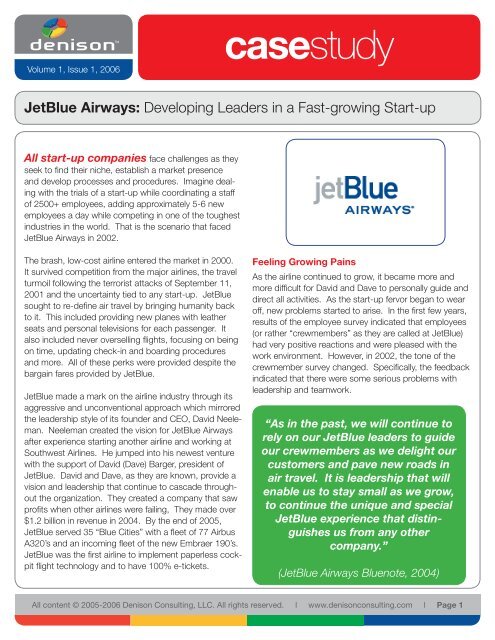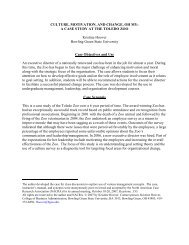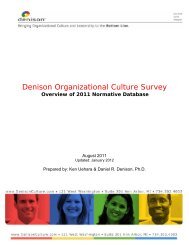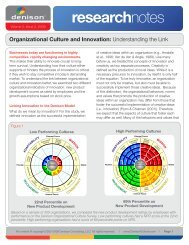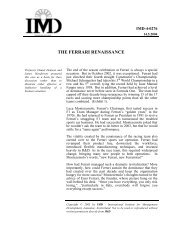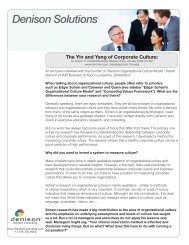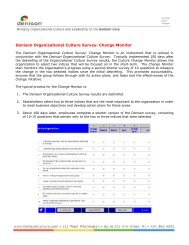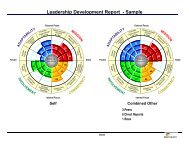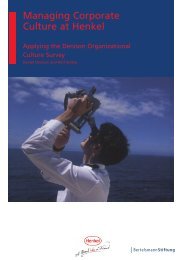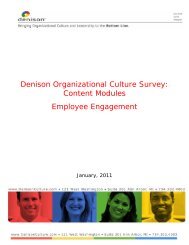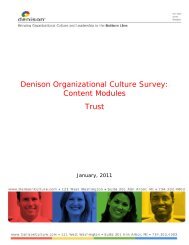JetBlue Airways - Denison Consulting
JetBlue Airways - Denison Consulting
JetBlue Airways - Denison Consulting
You also want an ePaper? Increase the reach of your titles
YUMPU automatically turns print PDFs into web optimized ePapers that Google loves.
casestudyVolume 1, Issue 1, 2006<strong>JetBlue</strong> <strong>Airways</strong>: Developing Leaders in a Fast-growing Start-upAll start-up companies face challenges as theyseek to find their niche, establish a market presenceand develop processes and procedures. Imagine dealingwith the trials of a start-up while coordinating a staffof 2500+ employees, adding approximately 5-6 newemployees a day while competing in one of the toughestindustries in the world. That is the scenario that faced<strong>JetBlue</strong> <strong>Airways</strong> in 2002.The brash, low-cost airline entered the market in 2000.It survived competition from the major airlines, the travelturmoil following the terrorist attacks of September 11,2001 and the uncertainty tied to any start-up. <strong>JetBlue</strong>sought to re-define air travel by bringing humanity backto it. This included providing new planes with leatherseats and personal televisions for each passenger. Italso included never overselling flights, focusing on beingon time, updating check-in and boarding proceduresand more. All of these perks were provided despite thebargain fares provided by <strong>JetBlue</strong>.<strong>JetBlue</strong> made a mark on the airline industry through itsaggressive and unconventional approach which mirroredthe leadership style of its founder and CEO, David Neeleman.Neeleman created the vision for <strong>JetBlue</strong> <strong>Airways</strong>after experience starting another airline and working atSouthwest Airlines. He jumped into his newest venturewith the support of David (Dave) Barger, president of<strong>JetBlue</strong>. David and Dave, as they are known, provide avision and leadership that continue to cascade throughoutthe organization. They created a company that sawprofits when other airlines were failing, They made over$1.2 billion in revenue in 2004. By the end of 2005,<strong>JetBlue</strong> served 35 “Blue Cities” with a fleet of 77 AirbusA320’s and an incoming fleet of the new Embraer 190’s.<strong>JetBlue</strong> was the first airline to implement paperless cockpitflight technology and to have 100% e-tickets.Feeling Growing PainsAs the airline continued to grow, it became more andmore difficult for David and Dave to personally guide anddirect all activities. As the start-up fervor began to wearoff, new problems started to arise. In the first few years,results of the employee survey indicated that employees(or rather “crewmembers” as they are called at <strong>JetBlue</strong>)had very positive reactions and were pleased with thework environment. However, in 2002, the tone of thecrewmember survey changed. Specifically, the feedbackindicated that there were some serious problems withleadership and teamwork.“As in the past, we will continue torely on our <strong>JetBlue</strong> leaders to guideour crewmembers as we delight ourcustomers and pave new roads inair travel. It is leadership that willenable us to stay small as we grow,to continue the unique and special<strong>JetBlue</strong> experience that distinguishesus from any othercompany.”(<strong>JetBlue</strong> <strong>Airways</strong> Bluenote, 2004)All content © 2005-2006 <strong>Denison</strong> <strong>Consulting</strong>, LLC. All rights reserved. l www.denisonconsulting.com l Page 1
Facing a Leadership GapWith the airline growing so quickly, many crewmemberswere hired or promoted without having much supervisoryexperience. The lack of experience and guidancequickly became a problem. Supervisors and managerswere creating a workplace that did not reflect the leadershipspirit that David and Dave wanted to promote. Amemo to crewmembers stated, “As in the past, we willcontinue to rely on our <strong>JetBlue</strong> Leaders to guide ourCrewmembers as we delight our Customers and pavenew roads in air travel. It is leadership that will enableus to stay small as we grow, to continue the unique andspecial <strong>JetBlue</strong> experience that distinguishes us fromany other company.” (Bluenote, 2004) In order to improveand expand leadership, they tasked the Learningand Development (L&D) group with creating an intenseleadership program that would be required for anyone ina leadership role. The leadership planning initiative wasspearheaded by Deborah McCuiston, Manager of L&D,and Shawn Overcast, Supervisor of Crewmember Experienceand Impact. After an intense period of researchand planning, a series of courses named the Principles ofLeadership (POL) was born. “POL is sort of a mid-flightcorrection – a response to some troubling evidence that<strong>JetBlue</strong>’s culture was already starting to stray off course.”(Salter, 2004).Setting Leadership StandardsMcCuiston, Overcast and their L&D team faced the challengeof creating a leadership program in an organizationthat did not have a documented leadership philosophy.In order to develop a program that would tie to the strategyof the company, they worked with senior leaders todefine leadership principles. All of the POL courses weredesigned around five principles that all <strong>JetBlue</strong> leadersare expected to embody.<strong>JetBlue</strong> Leadership Principles1. Treat Your People Right2. Do the Right Thing3. Communicate with Your Team4. Encourage Initiative and Innovation5. Inspire Greatness in OthersThe first course, called POL Foundations, is a 2 daycourse that introduces the 5 leadership principles andalso covers critical human resources topics such asdrug and alcohol awareness and harassment prevention.POL Foundations also creates a legacy of leadership,because most of the course is taught by members of theExecutive Crew. David and Dave as well as other seniorleaders take the time and interest to pass along theprinciples and expectations. <strong>JetBlue</strong> believes in leadersteaching leaders. After completing POL Foundations,the leaders take an intensive 3 day course called POLin Action, which focuses more on skill building. <strong>JetBlue</strong>also provides continuous education through a series ofexpert lectures called Leadership Link. <strong>JetBlue</strong> has astrong committment to training leaders. By the end of2005, they had completed 35 classes of POL Foundations(1179 students), 33 classes of POL in Action (594students) and 2 Leadership Links (212 participants).Developing POL In ActionThe POL in Action course moves beyond the basics ofleadership and focuses on building effective leadershipskills through feedback, coaching and personal leadershipeffectiveness. It teaches crewmembers to buildrelationships with their teams. This class is taught byhighly skilled facilitators from L&D and also involves personalcoaches. Some sections are taught by operationaldirectors and managers in order to continue the theme ofleaders teaching leaders.In order to keep the training relevant and interesting,<strong>JetBlue</strong> has instituted many individualized elements. Forexample, leaders receive personalized attention andsupport, including a behavioral assessment, a leadership360 assessment, videotaped activities with feedbackreviews and a one-on-one feedback coaching session.The outcome of the class is a detailed action plan tosupport ongoing development and behavior change.This wide variety of assessments and learning strategiesalso helps reinforce the 5 leadership principles.The <strong>JetBlue</strong> developers did extensive research to find thetools and concepts that would be most effective in theirhigh-paced, growing environment. Instead of selecting acanned leadership training vendor, they created a bestin-classprogram that would change the way businesswas done at <strong>JetBlue</strong>. It took hundreds of hours of research,instructional design, development and testing tofind the perfect combination of practical and theoreticaltraining elements. The <strong>JetBlue</strong> L&D team continues toseek feedback on the course and update it as needed.All content © 2005-2006 <strong>Denison</strong> <strong>Consulting</strong>, LLC. All rights reserved. l www.denisonconsulting.com l Page 2
Using the <strong>Denison</strong> Leadership Development Survey (DLDS)When designing the POL in Action course, the L&D team compared the usefulness of several types of individualassessments. They were intesrested in using a 360 feedback assessment, but had some concerns as well. Is 360feedback right for <strong>JetBlue</strong>? Can we keep it separate from the performance management process? Can it be usefulwithout being intimidating?<strong>JetBlue</strong> conducted an extensive search to find the right 360 survey tool for the organization. They chose the <strong>Denison</strong>Leadership Development Survey (DLDS) to guide personal development and aid in the coaching sessions. Onereason for choosing the DLDS was that the <strong>Denison</strong> model linked seamlessly to the five <strong>JetBlue</strong> Principles of Leadership.A second reason was that the DLDS had a bottom-line business focus. With a cynical audience, the surveyhad to be business-oriented and not have a lot of fluff. Finally, the DLDS provided easy-to-interpret feedback whichhelped participants and feedback coaches. As the introductory note from David and Dave states, “…the purposeof the survey is for <strong>JetBlue</strong> Leaders to learn – about how others see them, about how they are living the Principles ofLeadership, and about how they can improve.”To emphasize the link between the DLDS and the <strong>JetBlue</strong> principles of leadership, <strong>JetBlue</strong> created a modified versionof the <strong>Denison</strong> circumplex for the feedback reports. The revised model displays the names of the <strong>JetBlue</strong> principlesnext to the names of the <strong>Denison</strong> traits (see the circumplex comparison below). <strong>JetBlue</strong> also modified someof the survey items. Although they did not change the meaning of the items, they changed the word “employee” to“crewmember” in order to reflect the accepted verbiage at <strong>JetBlue</strong>.The participants complete the DLDS as part of the pre-work for the class – completion of the survey is a requirementfor attendance. The DLDS uses the <strong>Denison</strong> model to measure the effectiveness of leaders based on feedback fromthemselves, boss(es), peers, direct reports and other colleagues. Each leader goes online to complete a self surveyand to select 3 to 5 peers to complete the survey about the leader, 3-5 direct reports to complete the survey and toindicate their boss. In the feedback reports, bosses are identified by name, but the results from other respondentsare aggregated, so respondents remain anonymous. <strong>JetBlue</strong> addressed its leadership gap by developing an intensiveclassroom course that uses the <strong>Denison</strong> Leadership survey to foster individual development.Standard <strong>Denison</strong> Leadership DevelopmentSurvey (DLDS) circumplex.<strong>JetBlue</strong>-ized Leadership Development Surveycircumplex.All content © 2005-2006 <strong>Denison</strong> <strong>Consulting</strong>, LLC. All rights reserved. l www.denisonconsulting.com l Page 3
“Scaling Neeleman”: Moving Beyond a Charismatic LeaderAs described in this story, David Neeleman is a largerthan-lifeleader who is credited with creating the successof <strong>JetBlue</strong> <strong>Airways</strong>. Neeleman is an entrepreneurwho dropped out of college to start Morris Air, whichwas eventually bought by Southwest Airlines. He triedworking in the established Southwest organization, butfound that his innovative spirit and ideas did not fit well.He left Southwest to start several airline-related companiesuntil his non-compete agreement with Southwestexpired and he could start <strong>JetBlue</strong>. Neeleman’s dyamicleadership propelled <strong>JetBlue</strong> to success. But this leadsto a question: Can <strong>JetBlue</strong> maintain the Neeleman spiritand culture as it grows larger in size and number of crewmembers? As Chuck Salter asked in Fast Companymagazine (2004): “In many ways, the question of whether<strong>JetBlue</strong> can do all of this – grow and standardizeand automate – while still preserving its personal touchcomes down to this: Can Neeleman be scaled?”Research and experience tell us that charismatic leaderscan have a powerful influence on an organization. Theyare dynamic and compelling and create a strong senseof loyalty among followers. Although a charismaticleader can create a positive legacy, there is also someinherent risk. The risk is that the organization builds itselfon the skills and personality and leadership of that oneperson. When that person is gone, or cannot touchevery part of the organization, the fallout can be dramatic.Organizations with charismatic leaders must alwaysconsider the long-term and develop future leaders andstructures that will endure after the charismatic leader isgone. <strong>JetBlue</strong> is meeting this challenge head-on. Theyare implementing many programs to ensure long-termleadership success at <strong>JetBlue</strong> <strong>Airways</strong>. Some of theirefforts include:1. Choosing Strong Leaders: Neeleman chose exectutivesand managers that share and live the <strong>JetBlue</strong>principles of leadership. They reinforce the principlesthrough their everyday activities.2. Developing Training: <strong>JetBlue</strong> committed to creatingbest-in-class leadership training - and built the Principlesof Leadership courses from the ground up.3. Connecting to the Operation: All senior leadersare required to be involved in the operations. Many ofthe senior leaders are pilots and actually do flights eachmonth. All leaders are also assigned a “Blue City” andvisit the operations in their assigned city at least once aquarter to check in and gather feedback.4. Maintaining a Dialog: <strong>JetBlue</strong> seeks frequent feedbackfrom crew members. This includes feedback aftertraining as well as an annual employee survey. Eachdepartment builds an action plan based on these results.Related Resources<strong>Denison</strong> <strong>Consulting</strong>. (2005). Research Notes: Overview of the<strong>Denison</strong> Model. Ann Arbor, MI: Author.<strong>Denison</strong> <strong>Consulting</strong>. (2000). <strong>Denison</strong> Leadership DevelopmentSurvey (DLDS). Ann Arbor, MI: Author.Peterson, B. S. (2004). Blue Streak: Inside <strong>JetBlue</strong> the Upstartthat Rocked an Industry, Penguin Group: New York.Salter, C. (May 2004). And Now the Hard Part, Fast Company,82, p. 66-75.<strong>JetBlue</strong> <strong>Airways</strong>. (2004). Bluenote: POL Soars into 2004: YourRole in Leadership Development. Forest Hills, NY: Author.Contact Information<strong>Denison</strong> <strong>Consulting</strong>, LLC121 West Washington, Suite 201Ann Arbor Michigan 48104Phone: (734) 302-4002Fax: (734) 302-4023Email: research@denisonconsulting.comCopyright InformationCopyright 2005-2006 <strong>Denison</strong> <strong>Consulting</strong>, LLC.All Rights Reserved.Unauthorized reproduction, in any manner, is prohibited.The <strong>Denison</strong> model, circumplex and survey are trademarks of<strong>Denison</strong> <strong>Consulting</strong>, LLC.CS Version 1.0, February 2006All content © 2005-2006 <strong>Denison</strong> <strong>Consulting</strong>, LLC. All rights reserved. l www.denisonconsulting.com l Page 4


